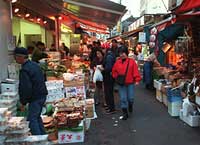|
|
|||||||
|
|
|||||||
|
|||||||
| | Web Japan >>| Trends in Japan >> | Lifestyle >> | Tourists Flock to Tsukiji | |
|
TOURISTS FLOCK TO TSUKIJI Fish Market Attracts Foreign Visitors (December 1, 2004) Tokyo's Tsukiji Fish Market is enjoying booming popularity among foreign tourists, who go there not only to take a look around the bustling marketplace but also to lunch on some of the freshest sushi in Japan. Tsukiji is by far the most popular destination among the various tours for foreign visitors offered by a leading bus tour operator. Viewing and tasting the astonishing variety of fresh seafood and other foods on offer at the market is seen by many foreign visitors as an excellent way to familiarize oneself with Japanese culture. More Tours with English Guides The tour's other stops include the Hamarikyu Onshi Garden, a stunning example of traditional Japanese aesthetics, and the Edo-Tokyo Museum, but it is Tsukiji Market that the participants most look forward to. Hato Bus has scored a direct hit with this service aimed at increasing its foreign clientele, and the popularity of the Edo Tokyo tour is soaring. Last year the tour ran on Fridays, Saturdays, and Sundays, but in response to customer requests this year it has been increased to four times a week, on Tuesdays, Thursdays, Fridays, and Saturdays. When a tour group arrives at Tsukiji Market, first the guide gives an overview of the market's setup and explains how deals are done among the traders, and then the eager visitors get to look around the marketplace. It all takes about two hours, at the end of which many of the participants eat sushi or other fresh dishes for lunch at one of the nearby eateries. Among the most popular souvenirs of a visit to Tsukiji are wax replicas of Japanese foods like sushi and soba (buckwheat noodles) and boots like those worn by the market traders, and tour participants can often be seen carrying these purchases in the bamboo baskets that are also on sale. A middle-aged French couple who joined one of the tours commented, "I'm sure that Japanese people enjoy looking around markets when they travel in their own country. When you're traveling abroad, markets are a must see. Foreigners visiting Japan are the same. The best way to understand another culture is to take a good look at the foods in the market and then try the food for real. I think this idea is universal." Strategies to Attract Foreign Tourists The flow of fish, vegetables, and other foodstuffs arriving at the market from all over Japan and around the world never stops. Wholesalers sell their produce to distributors, who then sell it on to retailers and professional chefs. The area where this trading takes place is known as the "inner market." Entry is in principle restricted to professionals, so it is inaccessible to the general public. In a corner next to the inner market, however, is a mass of about 500 shops selling fresh seafood, dried goods, meat, and many other foods. This is the "outer market," which is accessible to everyone. The reputation of this market for stocking a rich variety of fresh, tasty, and inexpensive foodstuffs has filtered through to the general public, who have begun frequenting the market in ever-increasing numbers. It is mainly this outer market that foreign tourists get to see when they visit. Faced with a prolonged consumer slump, many of the shops at the market started actively trying to attract ordinary shoppers and foreign tourists. In April 2002 an association of about 100 Tsukiji shops was formed, bringing together many of the oldest outlets in the market. Among the association's initiatives so far has been the launch of special Saturday-only events to bring in more visitors. These have included sales of chashu (roast pork) for ¥200 ($1.82) per 100 grams and omelette-making classes given by a specialist Japanese omelette shop with a tradition stretching back 80 years. One of the founders of the shop association, who operates a ceramics store, says that the number of foreign visitors to Tsukiji has doubled in the past five years, and the popularity of this unique Tokyo landmark is likely to continue rising as word spreads further. Related Web SitesTsukiji Fish Market Hato Bus Co. Edo-Tokyo Museum Copyright (c) 2004 Web Japan. Edited by Japan Echo Inc. based on domestic Japanese news sources. Articles presented here are offered for reference purposes and do not necessarily represent the policy or views of the Japanese Government. |
WHAT PLACES WOULD YOU RECOMMEND TO FOREIGN TOURISTS? (April 15, 2004) CENTRAL TOKYO REBORN (June 19, 2003) TOURING TOKYO (April 18, 2003) |
|
|



